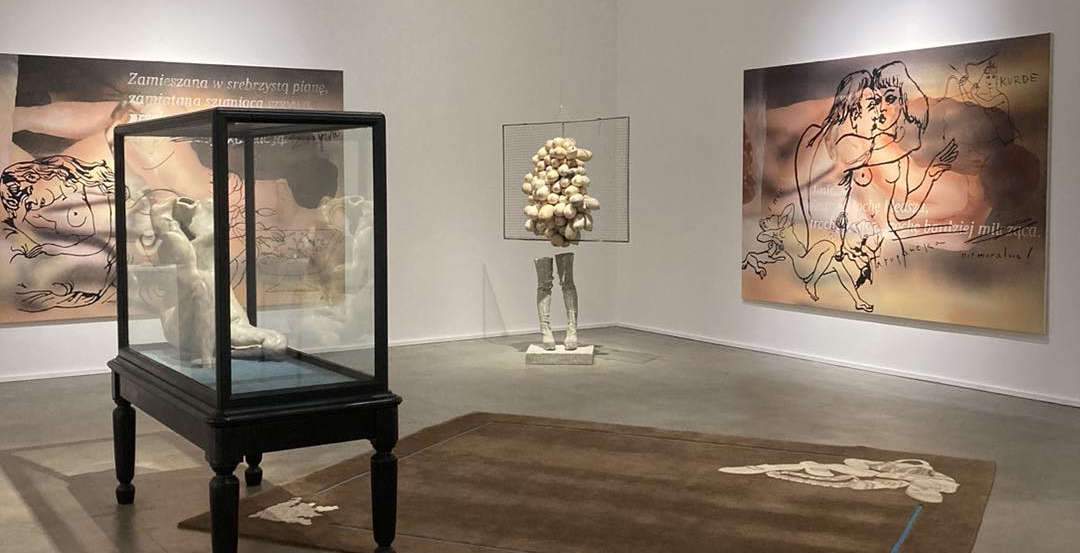From Nov. 2 to Feb. 25, 2024, Fondazione Sandretto Re Rebaudengo presents Visual Persuasion, an unprecedented and ambitious exhibition project conceived by Paulina Olowska (Gdansk, 1976), the largest exhibition ever dedicated to the artist by an Italian institution. An anthological exhibition of existing works and new productions, an artist-curated selection of works from the Sandretto Re Rebaudengo collection, a stage that welcomes a host of guests and spirits: Visual Persuasion is a multifaceted, polyphonic and immersive space, warped by Olowska to explore the dynamics of desire and eroticism redefined from a female perspective.
The exhibition draws its title and inspiration from a book published in 1961 in the United States by publicist Stephen Baker, who through reference to media theories and techniques, combined images and texts in order to analyze the effects of visual communication on the subconscious. Through what mechanisms do images exert their seductive power, become vectors of desire? Always fascinated and influenced by the languages of advertising, graphic design and fashion, Olowska adopts the concept of persuasion as an artistic and curatorial principle to construct the exhibition, a montage of works and images that gives shape to associations and suggestions, emotions and fantasies.
Within this imaginative universe, the female figure is both object and subject of the seductive action, embodying multiple roles and clichés, from different eras and cultures: bewitching icon, femme fatale, mischievous nymph, perverse dominatrix, demonic spirit, languid mannequin, uninhibited bourgeoisie and confident sex worker. Woman is also, above all, an artist, a creator, a maverick intellectual, as in the case of Maja Berezowska (1898-1978), among the muses of this project, a painter and illustrator, author of images bordering between eroticism and pornography.
Through the works of Olowska and the other artists she invited, this phantasmagoria of desiring and desired women materializes in a plurality of forms and languages: from painting to collage, ceramics to video, installation to performance. Olowska projects this spectacle in an ideal context, that of the city at night, a web of streets illuminated by the signs of clubs, bars and cinemas, a city that does not sleep, and that relentlessly feeds the machine of consumerist and erotic desire.
The architecture of the exhibition conceived by the artist transforms the space of the Foundation to offer an immersive, cinematic experience, dominated by the new, large site-specific installation of neon, a very important medium in Olowska’s artistic practice. An emblem of advertising communication in urban space, neon has strong ties to both the applied arts and art history, a combination dear to Olowska, who has particularly explored the history of the signs that decorated the city of Warsaw during the time of the socialist regime. Often lacking a specific commercial purpose, these neons became symbols of a consumerism in the absence of a referent, pure signs of desire itself and its relationship to urban experience.
At the exhibition opening on Nov. 2, Olowska will present a new performance, featuring singer Pat Dudek, that revisits and develops the project Naughty Nymphs presented at theArt Institute of Chicago in 2022. The work draws inspiration from the soft porn style of VIVA, an adult magazine for women published in the 1970s in the U.S., and is also developed through installation interventions that populate the Foundation’s restaurant, cafeteria and bookshop area. Here a series of paintings on fabric, in dialogue with a video installation, converges the steamy aesthetics of porno chic with American modernist abstractionism and neoclassical sculpture in a proliferation of historical, political and cultural references that produces new meanings. In Olowska’s work, the past is a living place that never stops generating images, producing encounters, creating alliances, and projecting ideas and dreams forward.
Paulina Olowska was born in 1976 in Gdansk, Poland; she lives in Rabka Zdroj and Krakow, Poland. She has had solo exhibitions at Kistefos Museum, Oslo; Kunsthalle Basel; Stedelijk Museum, Amsterdam; Zacheta National Gallery of Art, Warsaw. Olowska received the prestigious Aachen Art Prize in 2014. She has made performances at the Art Institute of Chicago; Tate Modern, London; Carnegie International; Museum of Modern Art, New York; Kitchen, New York; Museo del Novecento, Milan. His work has been included in international exhibitions such as the Venice Biennale and Liverpool Biennial, as well as in group exhibitions at mumok, Vienna; Hamburger Kunsthalle, Hamburg; Migros Museum Für Gegenwartskunst, Zürich; New Museum, New York, among many others.
Featuring selected works from the Sandretto Re Rebaudengo Collection by Tauba Auberbach, Vanessa Beecroft, Berlinde De Bruyckere, Trisha Donnelly, Peter Fischli and David Weiss, Sylvie Fleury, Nan Goldin, Dominique Gonzalez-Foerster, Mona Hatoum, Thomas Hirschhorn, Piotr Janas, Elena Kovylina, Barbara Kruger, Sherrie Levine, Sarah Lucas, Tracey Moffatt, Catherine Opie, Diego Perrone, Charles Ray, Cindy Sherman, Simon Starling and Richard Wentworth.
With works and contributions by Maya Berezowska, Walerian Borowczyk, Pat Dudek, Irini Karayannopoulou, Sylvere Lotringer and Julie Verhoeven.
For all information, you can visit the official website of Fondazione Sandretto Re Rebaudengo.
Pictured: Paulina Olowska, Seductress (2020), oil on canvas, 170x110 cm. Christen Sveaas Art Collection
 |
| Turin, at Fondazione Sandretto the solo exhibition of Polish artist Paulina Olowska |
Warning: the translation into English of the original Italian article was created using automatic tools. We undertake to review all articles, but we do not guarantee the total absence of inaccuracies in the translation due to the program. You can find the original by clicking on the ITA button. If you find any mistake,please contact us.